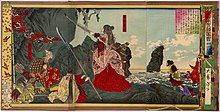Jingu

Jingū ( Japanese 神功 皇后 , Jingū-kōgō ; * ~ 169 ; † 269 ) was a consort of Chūai -tennō and after the death of her husband in 201 until her son Ōjin -tennō's accession to the throne in 269, she was regent and the myths de facto Ruler of Japan .
history
According to legend, she led an invading army into Korea and returned to Japan victorious after three years. Their son Ōjin was born on their return.
The legend of Jingū's invasion of the Korean peninsula is based on the traditional Japanese interpretation of the Gwanggaeto stele found in Manchuria . This declared the predominance of Goguryeo over Manchuria and the northern part of Korea. Further investigation showed that this interpretation was based on guesswork, as several important letters from the text were missing. In addition, the connections are more in line with Goguryeo's direct southern neighbors Silla and Paekche . Paekche had very close ties with Japan, including inter-court exchanges, and was one of the main routes of transferring continental culture to Japan.
Most modern historians, including the Japanese, reject the legend of Jingū. The story of their reign could have been invented to explain the interregnum from 200 to 270 mentioned in the Kojiki and Nihonshoki .
According to Arai Hakuseki , Jingū is identical to Queen Himiko , as the authors of Nihonshoki had to regard the latter as a historical figure as belonging to the imperial family. However, more recent research now ruled out an identity between Jingū and Himiko. According to scientific evidence, Himiko lived at least 120 years before Jingū, provided that Jingū was even a historical person.

In 1881, Jingū was the first woman on a Japanese banknote.
Shinto
Jingū-kōgō is said to have built several shrines, including the Kashii-gū (Kashii, Fukuoka ) in 199 , in which Chūai -tennō is worshiped. After her return from Korea, she is said to have founded a number of shrines in the Kobe - Osaka region, including the Ikuta Shrine in 210, the Nagata Shrine in Kobe, the Hirota Shrine in Nishinomiya and the Sumiyoshi Taisha in Osaka. In addition, she is credited with founding the Mekari Shrine in the Moji-ku district of Kitakyushu City .
Jingū is venerated as a Kami in several shrines and is mostly associated with her son, for example in the Sumiyoshi Taisha in Osaka, in the Togi-hachiman-gū in Shika (formerly Togi-machi, Ishikawa Prefecture ), in the Kameyama Shrine in Kure , in Himure-hachiman-gū in Ōmi-hachiman ( Shiga Prefecture ), in Shinzen-chō Hachiman-gū in Nagahama (Shiga Prefecture) and in Shikawa-mura Hachiman-gū ( Shimane Prefecture ). As a Kami, she bears the name Okinaga-tarashi-hime (no mikoto), whereby three spellings are used for this name: 気 長足 姫 尊 , 息 長 帯 比 売 命 and 大 帯 比 売 命 .
Furthermore, she is venerated together with the two Kami Katsuma-no-ō-kami and Katsuyori-no-ō-kami (who are said to have been either their brothers or vassals) in the Miyachitake shrine. In the Itate-hyōzu shrine, the Kami Itate-no-kami is venerated, who is said to have defended the bow of their ship.
Individual evidence
- ^ Klaus Antoni: Kojiki - records of old incidents . 1st edition. Verlag der Weltreligionen, Berlin 2012, ISBN 978-3-458-70036-4 , p. 301 .
Web links
- Kadoya Atsushi: "Okinagatarashihime" . In: Encyclopedia of Shinto. Kokugaku-in , March 12, 2005 (English)
| personal data | |
|---|---|
| SURNAME | Jingu |
| ALTERNATIVE NAMES | Jingū-kōgō; 神功 皇后 (Japanese) |
| BRIEF DESCRIPTION | Wife of Chūai-tennō |
| DATE OF BIRTH | at 169 |
| DATE OF DEATH | 269 |
